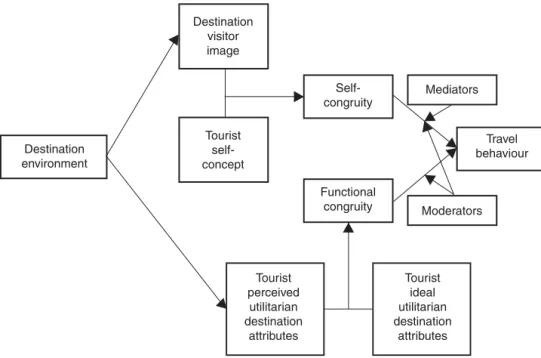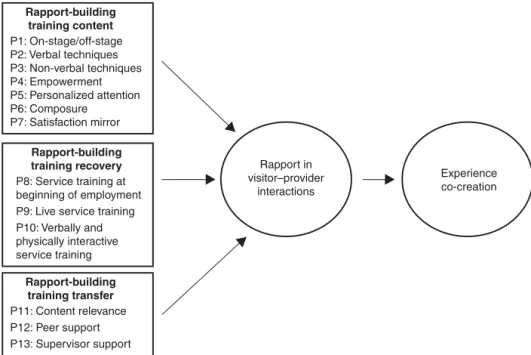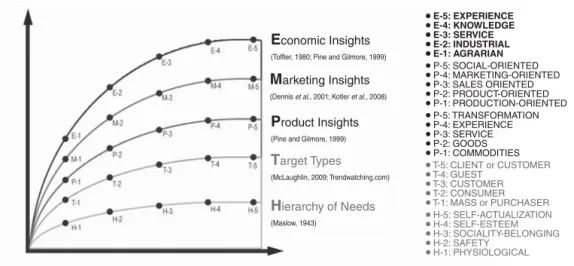Chathoth is Associate Professor at the Department of Marketing, School of Business and Management, American University of Sharjah, UAE. Dahl is an educational psychologist and professor at the Department of Psychology at the University of Tromsø, Norway.
Joseph Sirgy is a management psychologist and Professor of Marketing, and Virginia Real Estate Research Fellow at Virginia Polytechnic Institute and
Current research provides a multitude of approaches to value creation and co-creation and these approaches can contain a variety of features, and imply others, in an attempt to outline the essence of the. The tourist's interest, involvement, motivation and participation in value creation affect the tourist's value perceptions and future intentions.
Tourist Experience
This approach puts people at the center and considers tourism as an experience network where different stakeholders co-create to engage in tourism experiences. This means the importance of the setting where tourism activities take place in order to create value and create experiences.
Tourist Experience and Co-creation
Value is seen as value-in-use, and consumer experiences are fundamental to collaborative value creation. The commodity-dominant logic is based on the meaning of value-in-exchange, and that value is produced by the firm in the marketplace, usually through an exchange of goods and money (Vargo and Lusch, 2004; Vargo et al., 2010).
Phases of Tourist Experience Creation
Goff man (1967) focused on the intangible elements of experiences and the importance of the interactions between hosts and guests. Knowledge of the effect of the physical surroundings and service landscapes is extremely important for the tourism industry to develop innovative and valued service experiences.
Structure of the Book
Value is therefore considered to be in the experience and not in the object of consumption. These antecedents of value co-creation refer to different aspects of consumption that have attracted the attention of various scholars in the field.
Acknowledgements
In particular, we have attempted to structure the book in a way that provides a framework for distinguishing key sources or antecedents of customer value that appear to warrant consideration in analyzing consumer behavior. As a result, our contributors, representing eleven countries in these research areas, discuss whether and how their concerns fit into the thematic framework and offer further insights into the applicability of the antecedents of customer value co-creation, consumer process and interaction to a wide range of experiential environments research topics.
2013) Critical service logic: making sense of value creation and co-creation. 2004) Consumer-to-consumer conversations in service settings. 2011) Coping and co-creation in tourist experiences. 2000) Consumer participation in the production and provision of services. eds) Handbook of Services Marketing and Management.
Introduction
However, Cohen (1979) questioned the validity of the two aforementioned schools of thought regarding tourist experiences in light of the narrowly selected study samples. At the other extreme of the experience continuum, tourists who strive for existential experiences detach themselves most culturally and spiritually from their own society.
Empirical Undertakings Grounded on Experience Theories
This tendency to pursue desired experiences can best be described by Dilthey's concept of "mere" experience and "one" experience (Rickman, 1976). This may mean that the dimensions of experience may not necessarily be valid and applicable.
Factors Infl uencing the Creation of Tourist Experiences
It is likely that people will remember parts of the experience of attending and completely forget something they did during the trip. To further operationalize tourists' post-travel evaluation, this chapter takes a similar concept, albeit with different descriptors, to present the tourist's evaluation of the travel experience.
Incorporating the TEDM in Tourist Experience Creation
Exploring extraordinary experiences. 2012) Development of a Scale for Measuring Unforgettable Tourism Experiences. 2007) Some issues of the psychology of the tourist experience. Therefore, this chapter aims to improve our understanding of the concept of tourism experience by revealing the concept of value of tourism experience and present an updated research program based on this.
A Tripartite View on Tourist Experience
Tourism experiences are generated on stage in interactions with other actors in an active or passive way. Dimensions that influence the tourism experience are environmental conditions (factors that affect the five senses), space and function (arrangement of details in the room), signs, symbols and artifacts (signals about the company that affect the customer), and social interactions (Edvardsson et al., 2005).
Tourist Experience Value
Quality of life, happiness and well-being are presented in this section as mediating concepts with the argument that they are highly integrated and influence life satisfaction (Benckendorff et al., 2009). Life satisfaction is a comprehensive concept, which can be deconstructed and related to concepts such as quality of life, happiness and well-being.
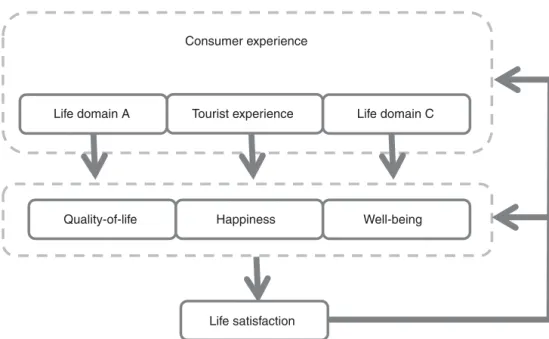
Summary
This chapter offers the concept of tourism experience value as a platform for bringing together the knowledge gained in many adjacent research disciplines (e.g. service marketing, consumer behaviour, tourism and quality of life). 2004) Co-creation experiences: The next practice of value creation. 2004) Towards a Structural Model of the Tourist Experience: An Illustration from Food Experiences in Tourism. 2009).
Theoretical Perspectives and Defi nitions
Note that "co-creation" differs from "customization" in that "the customer plays a less active role in customization than in co-creation" (Kristensson et al., 2008, p. 475). The engagement platform that integrates the firm's resources (material, labor and technology) with the customer is the essence of co-creation.
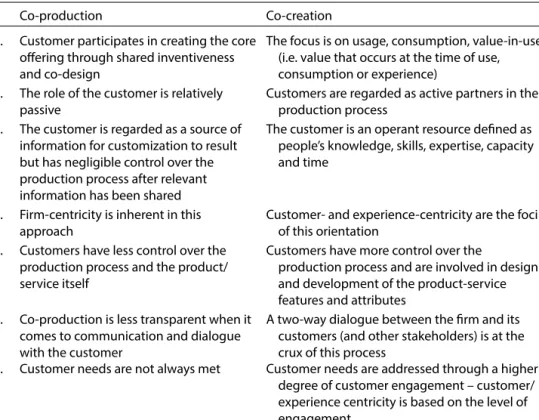
A Co-production/Co-creation Matrix
In the case of service innovations, customer cooperation and access are essential (Kristensson et al., 2008), which includes value in use in the production process. This is reflected in various improvements to hotel products. services such as buffets or a la carte menus tailored to the specific requirements of the Middle East2 and South Asian travel markets.3 In addition, Hong Kong International Airport now includes prayer rooms for Middle Eastern travelers who observe religious customs during their journey. 4 Incorporating such distinctive requirements of the target market into service production is essential to move towards more customer-centric modalities in the tourism context mentioned above.
Barriers to Moving Along the Co-production–Co-creation Continuum
As a result, a lack of trust in the organization may occur, leading to withdrawal from the organization (Kiefer, 2005). Employee participation in the change process is considered important for the acceptance of change (Lines, 2004).
The Co-production–Co-creation Continuum Framework
Cross-functional integration, training, communication, technology, organizational culture and facilitative leadership are considered to influence employees' affective commitment to change in the context of customer relationship management (Shum et al., 2008; Okumus et al., 2010). In the tourism example, consumers may have preconceived notions about the service process based on tradition and past experiences.
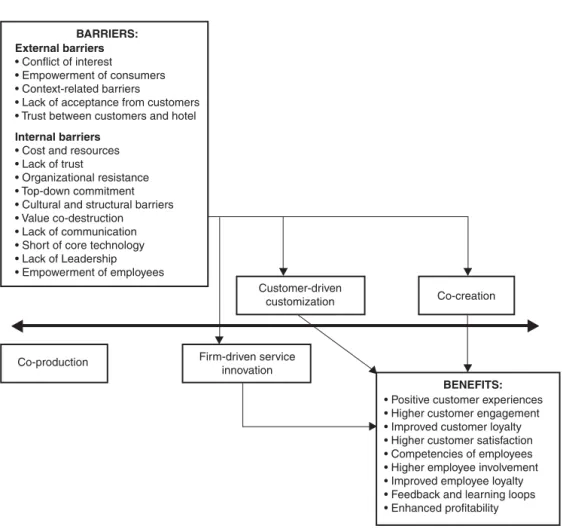
Implications, Conclusions and Future Directions
Similarly, internal barriers depend on the motivation and abilities of staff and leadership of the tourism organization. The implementation of service-dominant logic and the co-creation framework in the tourism context will also provide the required impetus to further develop the experiential elements of the tourism product.
Notes
International Journal of Hospitality Management Employee attitudes towards organizational change: A literature review. 2009) Operationalizing co-creation: service-dominant logic and the endless game. Key strategies for successfully involving customers in the co-creation of services based on new technologies.
G RAHAM M.S. D ANN
The latter observation is demonstrated by appealing to sociologists such as Cohen, Dann, MacCannell and Wang, all of whom offer theoretical insights into tourist motivation grounded in a corresponding experiential environment of social interaction. Jamal and Lee illustrate their point by referring to such classical thinkers as Veblen on conspicuous consumption (see Dann (1977) on ego enhancement as motivation) and by calling for more multidisciplinary research.
Diff erent Approaches to Researching Tourist Motivation
Together with psychologist Moscardo (forthcoming), who later cites more developed works by Maslow (Maslow, 1971; Maslow and Lowery, 1998), they also challenge the assumption that only tourism can provide correlated gratification, when a factor such as religion can fulfill that task. These pictorial images evoked a variety of expressions that contained many insights into the tourists' motivations that came from their own minds and experiences rather than from the prompting of the researcher.
Further Theoretical and Methodological Issues
This is the pre-trip choice exercise that is then transferred to the vacation destination where the tourist experiences during the trip are evaluated in terms of the previous discussion at the cognitive and affective levels. Furthermore, it is only by continuing to ask the final stage of driving motives that the researcher can begin to grasp the fullness of meaning for any individual or type of individual.
Testing/Critique of Single Motivation Hypotheses
Therefore, there is certainly a need for additional analysis along the lines of the inversionist perspective advocated by Gottlieb (1982). Here the experiential roles are reversed to the point where members of the working class seek compensation by becoming 'king or queen for a day', while the more stratified try to become 'peasants for a day'.
Testing/Critique of Dual Motivational Hypotheses
It is reinforced by Uysal et al., who state that ‘the tourism motivation literature indicates that the examination of motivations based on push and pull factors is widely accepted’. An additional advantage is that it is also applicable to the leisure domain (Prentice, 2004).
Testing/Critique of Multi-motivational Hypotheses
Conclusion: Some Unresolved Issues of Tourism Motivation
However, despite these various scientific insights, there still seems to be no consensus on the exact nature of the push and pull factors, followed by doubt as to the identity of the former and whether they are really what they claim to be. So this statement, despite the unaddressed terminological confusion, nevertheless highlights a worthy goal in itself.
Note
J OSEPH S IRGY
In 2000, Sirgy and Su developed an integrated model of self-consistency in travel and tourism. This means that increased self-congruity serves to increase value perception, which in turn has a positive role in the tourist's attitude towards the destination, preferences, choice, satisfaction, loyalty and word-of-mouth communication.
The Original Model
USA, Sirgy and Su (2000) proposed that ideal social self-congruity influences travel behavior. Ideal social self-congruity was found to be a significant predictor of tourists' cruise intentions.
Factors Aff ecting the Activation of Self-concept Dimensions
The ideal social self-image influences tourists' travel behavior through the social approval motive. That is, tourists who experience a match between the visitor image of a destination and their ideal social self-image will be motivated to visit that destination.
The Interrelationship between Self-congruity and Functional Congruity
Tourists who experience high self-congruity tend to view utilitarian attributes favorably and vice versa. Hung and Petrick (2011) conducted a study that tested self-congruity bias directly in relation to cruise intentions.
Broadening the Scope of the Travel Behaviour Construct
Distinguishing Between Destination Visitor Image and Destination Personality
And if so, self-congruence with destination personality should be a strong predictor of pre- and post-travel behavior. This notion of self-congruence with the personality of the destination (rather than with the image of the destination visitor) was empirically supported by research conducted by Ekinci and Riley (2003), Murphy et al.
Additional Moderators Distinguishing the Diff erential Eff ects of the Various Forms of Self-congruity
Formally speaking, self-congruence with destination personality is likely to influence pre- and post-travel behavior, as high self-congruence is expected to predict high levels of pre- and post-travel constructs. Formally speaking, the satisfaction of tourists from individualistic countries is probably more influenced by ideal self-conformity than that of tourists from collectivistic countries.
Distinguishing Between Self-congruity and Identity Salience
Tourists from individualistic countries are likely to place too much emphasis on how travel to the destination can realize their ideal self. Thus, self-congruity is likely to play a stronger role in predicting pre- and post-travel behavioral constructs, given that experienced self-congruity with a destination country is also associated with high identity salience.
Distinguishing Between Self-congruity and Destination Identifi cation
Some of these identities are more or less important to him, and some may conflict with the identity of 'I'm a party animal', while others may be highly consistent with the identity in question.
Does Self-congruity Infl uence Travel Behaviour? Or Does Travel Behaviour Infl uence Self-congruity?
Over time, they develop a self-congruity experience that further reinforces their attitude toward the tourist event, their intention for a repeat experience, and positive word-of-mouth. Formally stated: not only self-congruence affects travel behavior, but also travel behavior affects self-congruence.
Self-congruity Eff ects Over Time
The Diff erential Eff ects of Self-congruity vs Functional Congruity in Relation to Pre-travel vs Post-travel Behavioural Constructs
Furthermore, self-congruence is likely to play a stronger role in influencing place involvement, commitment and attachment than functional congruence.
Conclusion
1982) Self-concept in consumer behavior: a critical review. 1985a) Self-image/product-image congruence and consumer decision making. 2000) Destination image, self-congruity, and travel behavior: toward an integrative model. 1991) Self-congruity versus functional congruence: predictors of consumer behavior.
T OVE I. D AHL
This is the kind of thing that can happen when we care enough about things we least expect. It's also the power of stealth tourism – creating experiences that not only feed visitors' existing personal interests, but that can awaken and help them sustain new interests that are so powerful that visitors want to keep pursuing them. them even when they return home.
Interest
In informal, free-choice environments, on the other hand, other aspects of the learning process are involved. We realized that the fish was on the one hand both food for the whales we had already seen and the existence of the small coastal community we were visiting.
What Does It Take to Help People Develop Situational and Personal Interest?
In terms of correlations, it is assumed that in the triggered phase of situational interest meaning is hardly correlated with knowledge and affect, although knowledge and affect are slightly correlated. Those correlations become more equal in the phases of sustained situational and emergent individual interest and much higher in the final phase of well-developed individual interest.
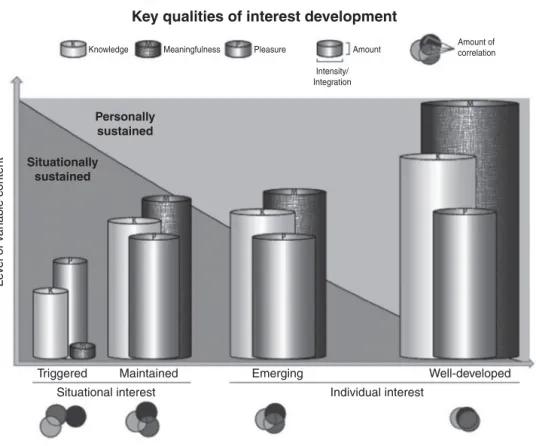
How Can Hosts Facilitate Interest Development?
The success of this approach therefore relates to the experiences visitors have and the ways in which they are used to help visitors develop new interests that are of value to them, the hosts and, ideally, the region. Providing the right incentives at the right time can bring about interest-related ways of thinking, feeling or acting with far-reaching ripple effects for visitors, hosts and the regions they meet.
Does Interest-related Learning Really Benefi t Visitors and Business?
Using the Model for Identifying Value Creation Principles
The interpretation of experiences for visitors within pre-selected themes provides a powerful starting point for the learning process (Ballantyne et al., 2011b). It is through the process of making sense of experiences that lasting meaning-making occurs and leaves a lasting impact (Kolb, 1984; Ballantyne et al., 2011b).
Next Steps
Do knowledge, positive aff ect and meaningfulness develop in the ways posited by the model?
Do the learning principles presented in this chapter affect movement between each of the four stages in predictable and/or stage-specific ways. In what ways does visitor interest benefit visitors, hosts and regions from development – directly and indirectly?
Closing Remarks
Since tourism destinations and firms need to engage tourists in order to provide them with satisfying experiences, the implementation of adequate strategies to obtain visitors' cooperation in the co-creation of experiences becomes essential. Strategies that can be adopted to encourage tourists' involvement with the tourism firms and destinations are provided at the end of the chapter.
Theoretical Framework for Involvement in the Context of Experience Co-creation
Another consequence of tourists' involvement profiles is that the number of options in tourists' awareness sets varies (Celsi and Olson, 1988; Bloch et al., 1989; . Cai et al., 2004). Furthermore, regarding tourists' perceptions of risk probability and importance, both identified as dimensions of involvement (Kyle et al., 2006), Havitz and Dimanche (1999) stated that perceived risk is lower for tourists who have a high involvement profile. .
Cases as Illustration
In this example, the company found a strategy through technology to engage and engage guests in a way that enables the co-creation of experiential value on both sides of the counter. He involved the participants in his discussion of nature and the forest, but also in the history of their country, in forgotten ways of life, in the heyday of the wooden shipbuilding industry....
Implications
Concluding Remarks
Current problems in tourism (in press). 2004) Towards a structural model of the tourism experience: An illustration of food experiences in tourism. 2012) T he dimensions of the tourism experience. eds) The tourism and leisure experience: consumer and managerial perspectives. However, the perception of the tourism product (both tangible and intangible) is unique for the consumer (Jewell and Crotts, 2002).
Literature Review
Tourists' motivations or experiences cannot be explained in terms of the conventional concepts of authenticity. Sharpley (1994) referred to authenticity in tourism as traditional culture and its origins, in the sense of the real, genuine and unique product.
The Case Study
The research study uses a qualitative research approach to explore authenticity as a co-creator of the cultural tourism experience. Ile-aux-Aigrettes Natural heritage Coastal forest with native plants and species, once home to the Dodo.
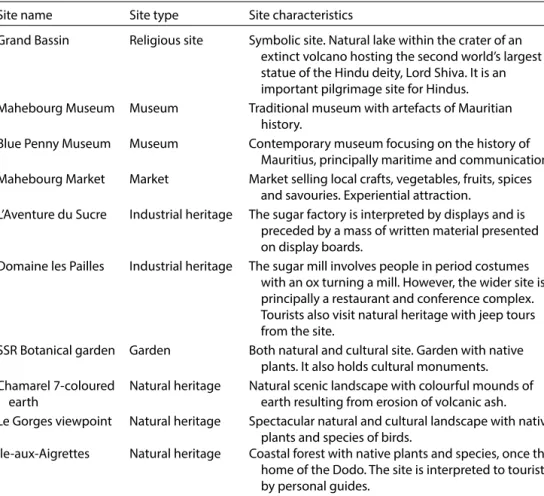
Discussion and Implications
This embodies the co-creation of the 'authentic' between the cultural tourist and the environment. This implies that existential, objective and experiential authenticity can play an important role in the co-creation of the authentic tourist experience.
Rapport-building Training: A Content Perspective
P4: Companies that include an empowerment component in their service training for their frontline workers will build better rapport with visitors than companies that do not have an empowerment training component. P6: Companies that include a calming component in their service training for their frontline workers will build better rapport with visitors than companies that do not have a calming training component.
Rapport-building Training: A Delivery Perspective
P7: Companies that include a satisfaction mirror component in their service training for their frontline workers will build better rapport with visitors than companies that do not have a satisfaction mirror training component. P10: Companies that provide verbal and physical interactive service training to their frontline employees will build better rapport with visitors than companies that do not use interactive techniques during the training session.
Rapport-building Training: A Training Transfer Perspective
P12: Training transfer will be maximized in companies that provide peer support for service training designed to build rapport. P13: Training transfer will be maximized in companies that provide supervisor support for service training designed to build rapport.
Discussion
The influence of general perceptions of the training environment on pre-training motivation and perceived training transfer. Work environment characteristics and implications for training transfer: a case study of the nuclear power industry.
Delimiting the Tourist Attraction Setting
Conceptualizations of Tourist Experiences
Furthermore, they state that 'relatively few studies have explored the components of experience that are most likely to be recalled by tourists' memories' (Kim et al., 2012, p describe the broader generic term 'meaningful experience'. Times Recently, there has been growing attention to an even stronger broadening of the perspective on tourism experiences, focusing on how they can contribute to improving the quality of life or well-being (Neal et al., 2007; Sirgy et al., 2011). ).
Approaches to the Measurement of Visitor Experiences of Attractions from Tourist Research Literature
As a result, many of the factors that affect satisfaction are difficult to control both from the perspective of researchers and managers (Tomas et al., 2002). The role of visitors' pre-visit cognitive 'maps' or 'schemas' has also been shown to be important in evaluating their emotional responses to what they are exposed to in a place, as shown by the resistance to assimilation approach (Vittersø et al., 2000).
Implications and Concluding Remarks
An examination of the effects of motivation and satisfaction on destination loyalty: a structural model. 2010). This chapter is a contribution to understanding the value-enhancing properties of storytelling, with a focus on co-creation.
The Power of Storytelling (as a Resource)
Indeed, communicative performance such as storytelling is described as essential in determining experiential quality and value (Arnould and Price, 1993; Arnould et al., 1998; Mossberg, 2008). Moreover, storytelling can not only increase the value created in interaction processes, in addition, the stories told during the life of the tourist experience have a greater chance of being remembered than listed facts or information (Graesser et al. , 2002).
Storytelling Management
This indicates that stories, similar to other situational stimuli, can increase tourist involvement and subsequent co-creation behaviors. Further, during interaction processes, tourists' involvement and co-creation behaviors influence their interpretation and reconstruction of destination brand narratives and destination brand meaning creation, which increases their experiential value (Green and Brock, 2000; Ballantyne and Aitken, 2007; Chronis et al., 2012).
Performing a Story: The Mobilization of Storytelling Resources
Further, the strength of tourists' involvement in particular contexts depends on the personal significance of the object or activity (Havitz and Manell, 2005; Ritchie et al., 2010). Well-developed stories have emotional appeal and can increase tourists' interest in the story through personal relevance (Ritchie et al., 2010).
Conclusion/Future Research
The economic approach tends to use a cost-benefit framework to determine the scope of the information search. This is followed by reviews of the psychological/motivational approach and the economic approach to information seeking.
Tourists’ Information Search and the Creation of Experience Value
The Internet is shown to provide experiential value by stimulating tourists in various ways before, during, after (and sometimes also instead of) their trip. The Internet allows for collaboration that can enable the creation of experiential value (Payne et al., 2008).
Theoretical Approaches to Information Search
The perceived costs and perceived benefits of information seeking are important predictors of the amount of information tourists seek (Vogt and Fesenmaier, 1989; Gursoy and McCleary, 2004). The Internet lowers the cost of searching for information (Gursoy and McCleary, 2004), helps meet multiple needs, and increases the value of the experience gained from searching.
Information Search: Before, During, After and Instead of Travel
Selection of activities is the part of the plan that changes most often (Jun et al., 2007) due to frequent updates of information and options. Sharing by word of mouth is one of the joys of tourism (Litwin et al., 2008).
Conclusions and Implications
This will help to increase the experiential value of searching for information and lead to additional usage. The change of competitive ways in the market and the direction of this change ultimately enforce the practices of value co-creation.
Co-creation of Value and Social Media
Social media services should be designed very carefully, as sharing is a natural and indispensable extension of the value co-creation process (Prahalad and Ramaswamy, 2002). The latest trend, dubbed “the market renaissance” by McLuhan, is experiential co-creation of value programs.
The Market Renaissance: Change in the Competitive Environment
While addressing value co-creation and the concept of social media, in this part of the book we aim to introduce the reasons for value co-creation by asking the 'how' question, moving from 'creating value for the customer'. to 'create value with the customer', rather than simply presenting companies' marketing practices.

